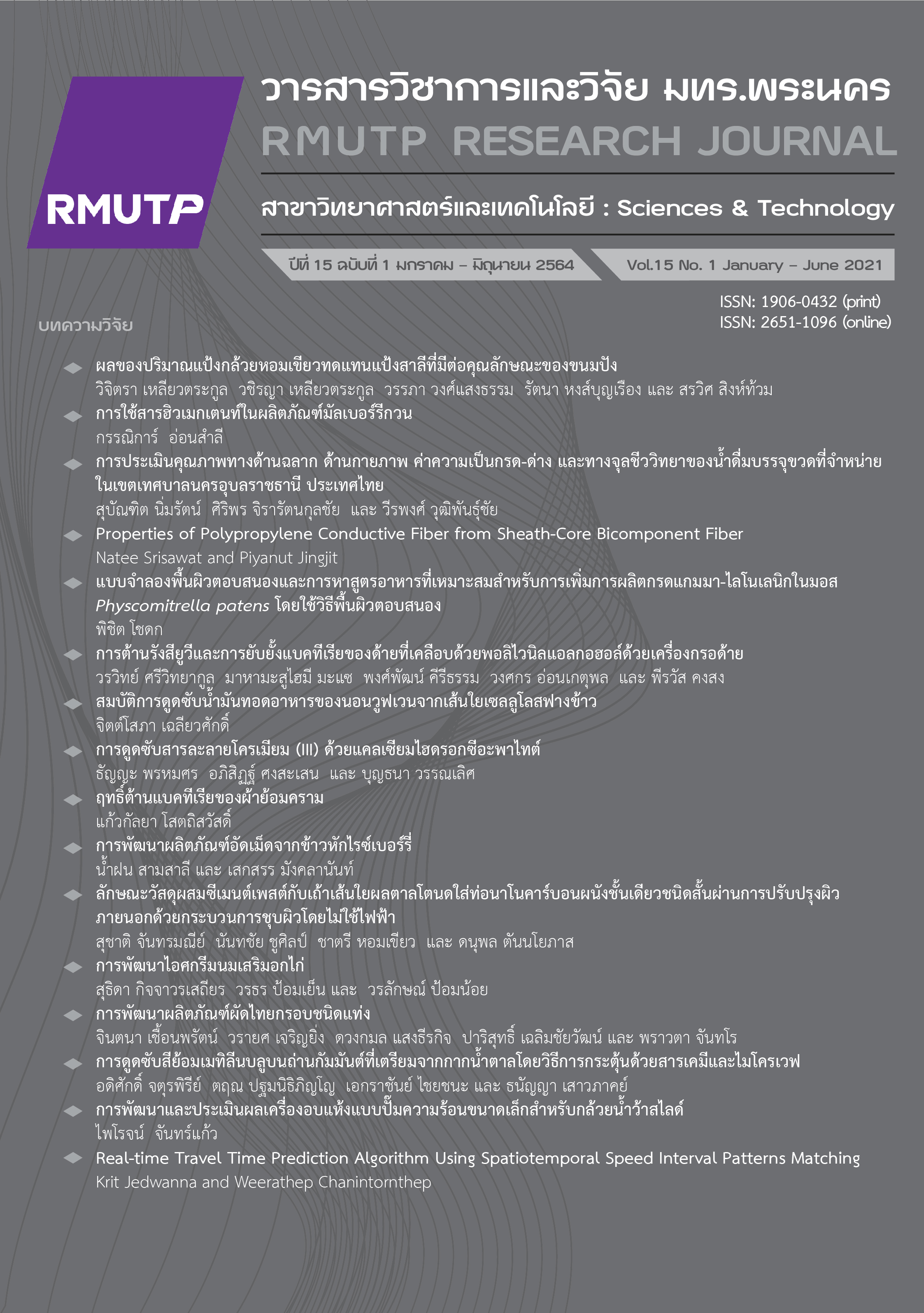Real-time Travel Time Prediction Algorithm Using Spatiotemporal Speed Interval Patterns Matching
Main Article Content
Abstract
Accurate, efficient and robust travel time prediction is crucial to the development of advanced traveler information systems for providing route guidance information. To achieve this goal, this paper proposed a travel time prediction through the matching of the current speed interval pattern to that in a historical database. Speed intervals, instead of speeds, are considered in this study to simplify the structure of matching patterns for improving matching efficiency. In this study, speed interval patterns are defined by sets of link speed intervals that are either spatially or temporarily correlated with the link considered. With the speed interval patterns, the algorithm is developed for searching the historical pattern(s) that is/are the closest match with the current one. Then, link speeds from these matched patterns are combined for travel time prediction. By using the GPS probe taxi data, which the collected speeds are aggregated in every 5 minutes, the proposed travel time prediction system is implemented in Bangkok. With the speed data from probe taxi, this paper has chosen four links/paths with different geometric and flow characteristics for testing the performance of the proposed travel time prediction system. From these tests, it is found that the optimal speed interval pattern should include: 1) speeds of the studied link within three preceding time intervals and; 2) speeds of links in the first connection level of the studied link. Also, while the computational time is capable of real-time application, the proposed prediction algorithm is more accurate under uninterrupted flow conditions.
Article Details
References
H.-E. Lin, R. Zito and M. Taylor, “A review of travel-time prediction in transport and logistica,” in Proceedings of the Eastern Asia Society For Transportation Studies, 2005, vol. 5, pp. 1433 – 1448.
N. K. Chowdhury, R. P. D. Nath, H. Lee and J. Chang, “Development of an Effective Travel Time Prediction Method Using Modified Moving Average Approach,” in Knowledge-Based and Intelligent Information and Engineering Systems, Berlin, Heidelberg, 2009, pp. 130–138.
W.H.K. Lam, K.S. Chan, M.L. Tam and J.W.Z. Shi, “Short-term travel time forecasts for transport information system in Hong Kong,” Journal of Advanced Transportation, vol. 39, no. 3, pp. 289-306, 2005.
S. I. Bajwa, E. Chung and M. Kuwahara, “An Adaptive Travel Time Prediction Model Based on Pattern Matching,” 11th Intelligent Transportation Systems World Congress, Nagoya, Japan, 2004.
T. Kim, H. Kim and D. J. Lovell, “Traffic flow forecasting: overcoming memoryless property in nearest neighbor non-parametric regression,” in Proceedings. 2005 IEEE Intelligent Transportation Systems, 2005, Sep. 2005, pp. 965–969.
Z.-P. Li, H. Yu, Y.-C. Liu and F.-Q. Liu, “An Improved Adaptive Exponential Smoothing Model for Short-term Travel Time Forecasting of Urban Arterial Street,” Acta Automatica Sinica, vol. 34, no. 11, pp. 1404–1409, Nov. 2008.
W.-H. Lee, S.-S. Tseng and S.-H. Tsai, “A knowledge based real-time travel time prediction system for urban network,” Expert Syst. Appl., vol. 36, pp. 4239–4247, Apr. 2009.
Y. Zhang and Y. Liu, “Comparison of Parametric and Non-Parametric Techniques for Non-Peak Traffic Forecasting.” International Journal of Mathematical and Computational Sciences, vol. 3, no. 3, pp. 8-14, 2009.
A. Khosravi, E. Mazloumi, S. Nahavandi, D. Creighton and J. W. C. Van Lint, “Prediction Intervals to Account for Uncertainties in Travel Time Prediction,” in IEEE Transactions on Intelligent Transportation Systems, vol. 12, no. 2, 2011, pp. 537-547.
A. Simroth and H. Zähle, “Travel Time Prediction Using Floating Car Data Applied to Logistics Planning,” IEEE Transactions on Intelligent Transportation Systems, vol. 12, no. 1, pp. 243–253, Mar. 2011.
W. Qiao, A. Haghani and M. Hamedi, “A Nonparametric Model for Short-Term Travel Time Prediction Using Bluetooth Data,” Journal of Intelligent Transportation Systems, vol. 17, no. 2, pp. 165–175, Apr. 2013.
Y. Zou, X. Zhu, Y. Zhang and X. Zeng, “A space–time diurnal method for short-term freeway travel time prediction,” Transportation Research Part C: Emerging Technologies, vol. 43, pp. 33–49, Jun. 2014.
H. Jiang, Y. Zou, S. Zhang, J. Tang and Y. Wang, “Short-Term Speed Prediction Using Remote Microwave Sensor Data: Machine Learning versus Statistical Model,” Mathematical Problems in Engineering, vol. 2016, p. e9236156, Feb. 2016.
W.H.K. Lam, M.L. Tam, A. Sumalee, C.L. Li, W. Chen, S.K. Kwok, Z. Li and E.W.T. Ngai, “ Incident detection based on short-term travel time forecasting,” in Proceedings of the 13th International Conference of Hong Kong Society for Transportation Studies: Transportation and Management Science, 2008, p. 83-92.
J.W.C. Van Lint, S. P. Hoogendoorn and H.J. van Zuylen, “Accurate Travel time Prediction with State-Space Neural Networks under Missing Data,” Transportation Research. Part C, vol. 13, pp. 347-369, 2005.
T. Siripirote, A. Sumalee, D. P. Watling and H. Shao, “Updating of Travel Behavior Model Parameters and Estimation of Vehicle Trip Chain Based on Plate Scanning,” Journal of Intelligent Transportation Systems, vol. 18, no. 4, pp. 393–409, Oct. 2014.
K. P. Hwang, W.-H. Lee and W.-B. Wu, “Travel time prediction by weighted fusion of probing vehicles and vehicle detectors data sources,” in 2012 12th International Conference on ITS Telecommunications, Nov. 2012, pp. 476–481.
BAL-Labs. (2010). “Siamtraffic1.0: Real-Time Travel Time Estimation.” BAL-Labs. [Online]. Available: http://bal.buu.ac.th/bal2010/?q=siamtraffic1.0
K. Sringiwai, N. Indra-Payoong and A. Sumalee, “RFID-based travel time estimation : development case in Bangkok,” in Proceeding of International Conference of Hong Kong Soceity for Transportation Studies, 2010, pp. 139-146.


